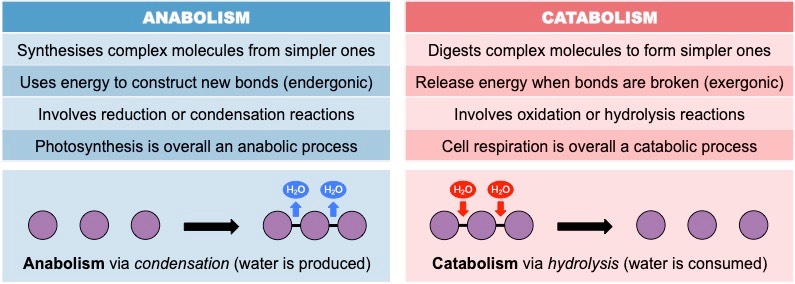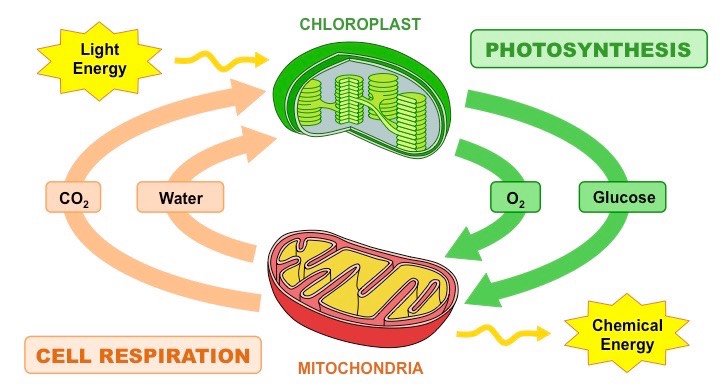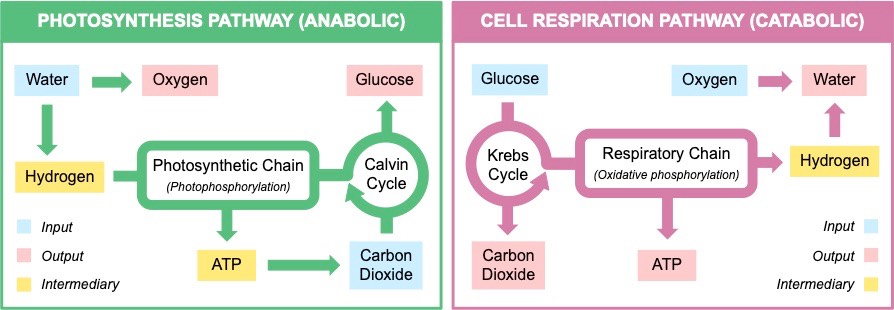Key Knowledge:
|
Most cellular processes involve chains and cycles of biochemical reactions, with each step controlled by a separate, specific enzyme
- Metabolism describes the totality of enzyme-catalysed reactions that occur within a living organism in order to maintain life
- Having metabolic pathways moderated by a series of sequential enzymes allows for a greater level of regulatory control
Types of Metabolic Reactions
Metabolic reactions can typically be categorised according to two main types: anabolic reactions or catabolic reactions
- Anabolic reactions build complex molecules from simpler subunits (for organic monomers, this involves condensation polymerisation)
- Catabolic reactions break down complex molecules into smaller components (for organic polymers, this involves hydrolysis reactions)

There are a variety of anabolic reactions that involve organic molecules (all of which can be reversed catabolically via hydrolysis)
- Monosaccharides (e.g. glucose) are joined via glycosidic linkages to form polysaccharides (e.g. glycogen or starch)
- Glycerol and fatty acids are joined to form triglycerides (or phospholipids if a phosphate group is also involved)
- Amino acids are joined via peptide bonds to form polypeptide chains (via the process of translation)
- Nucleotides are joined into polynucleotide chains (RNA or DNA) via the processes of trancription or DNA replication
Biochemical Pathways
Two examples of biochemical pathways which are complementary are photosynthesis (anabolic) and cellular respiration (catabolic)
- The products of photosynthesis function as the inputs of aerobic cellular respiration (oxygen and glucose)
- The products of aerobic cellular respiration function as the inputs of photosynthesis (carbon dioxide and water)
Most producers (i.e. photoautotrophs) will use both photosynthesis and cell respiration in order to survive, whereas consumers (heterotrophs) can only undertake cell respiration and rely on the ingestion or absorption of photosynthetic products to survive

Photosynthesis versus Cell Respiration
The general structure of the biochemical pathways in photosynthesis and cell respiration are effectively reversed
- Photosynthesis uses an electron transport chain to generate chemical energy for a subsequent Calvin cycle which forms glucose
- Aerobic respiration uses the Krebs cycle to break down glucose in order to generate energy (ATP) via an electron transport chain
Photosynthesis involves the anabolic production of glucose from inorganic components (using light as an initial energy source)
- Water is broken down by sunlight (photolysis) into hydrogen and oxygen (a waste product)
- Chlorophyll absorbs light energy which is used by an electron transport chain to produce ATP (photophosphorylation)
- The hydrogen is combined with carbon dioxide (and ATP) to form glucose via the Calvin cycle (i.e. anabolism)
Cell respiration involves the catabolic digestion of glucose into inorganic components (releasing chemical energy as ATP)
- Glucose is broken down into carbon dioxide and hydrogen via glycolysis and the Krebs cycle (i.e. catabolism)
- The hydrogen is used by an electron transport chain in order to produce ATP (oxidative phosphorylation)
- Oxygen collects the de-energised hydrogen to form water (a waste product)
